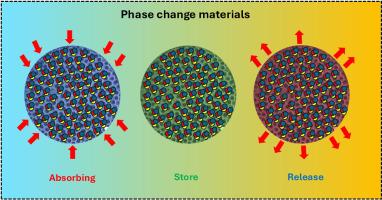形状稳定水合盐基改性硅藻土复合相变材料低温储热性能研究
IF 6.3
2区 材料科学
Q2 ENERGY & FUELS
引用次数: 0
摘要
水合盐具有高能量储存密度、低成本和不可燃性,是建筑热储能(TES)的有希望的候选者。然而,相分离和形状不稳定等挑战限制了它们的实际应用。使用硅藻土作为多孔支撑材料可以有效地解决这些问题。本研究的重点是通过真空浸渍法将三元共晶(T.E)盐水合物加入化学处理的硅藻土(D.T)中,以制备形状稳定相变材料(ss-PCMs),从而开发具有成本效益的热复合材料。采用扫描电镜(SEM)、傅里叶变换红外光谱(FT-IR)和差示扫描量热法(DSC)对复合材料的微观结构、化学稳定性、热性能和可靠性进行了表征。SEM分析证实了te盐成功浸渍硅藻土孔隙。得到的复合材料T.E1/D。T, T.E2 / D。T,和T. e3 /D。T的潜热值分别为95.42、119.7和106.13 kJ/kg。值得注意的是,T.E2/D。T复合材料显示出约68%的高盐负载效率,表明处理过的硅藻土具有封装大量PCM的能力。这种高效的封装提高了潜热容量,并在多个热循环中提供了出色的形状稳定性和热可靠性。这些发现强调了T.E2/D的强大潜力。T复合材料用于长期TES应用,特别是在提高建筑物的能源效率方面。本文章由计算机程序翻译,如有差异,请以英文原文为准。

Thermal performance of shape-stable hydrated salt-based modified diatomite composite phase change materials for low-temperature heat storage
Hydrated salts are promising candidates for thermal energy storage (TES) in buildings because of their high energy storage density, low cost, and non-flammable nature. However, challenges such as phase separation and shape instability limit their practical application. The use of diatomite as a porous support material can effectively address these issues. This study focuses on developing cost-effective thermal composites by incorporating ternary eutectic (T.E) salt hydrates into chemically treated diatomite (D.T) via the vacuum impregnation method to create shape-stabilized phase change materials (ss-PCMs). The microstructures, chemical stabilities, thermal properties, and reliability of the composites were characterized by scanning electron microscopy (SEM), Fourier transform infrared spectroscopy (FT-IR), and differential scanning calorimetry (DSC). SEM analysis confirmed the successful impregnation of the T.E salts into the diatomite pores. The resulting composites T.E1/D.T, T.E2/D.T, and T.E3/D.T exhibited latent heat values of 95.42, 119.7, and 106.13 kJ/kg, respectively. Notably, the T.E2/D.T composite demonstrated a high salt loading efficiency of approximately 68 %, indicating that the treated diatomite has the capacity to encapsulate a substantial amount of PCM. This efficient encapsulation enhances the latent heat capacity and provides excellent shape stability and thermal reliability across multiple thermal cycles. These findings underscore the strong potential of the T.E2/D.T composite for long-term TES applications, particularly in improving energy efficiency in buildings.
求助全文
通过发布文献求助,成功后即可免费获取论文全文。
去求助
来源期刊

Solar Energy Materials and Solar Cells
工程技术-材料科学:综合
CiteScore
12.60
自引率
11.60%
发文量
513
审稿时长
47 days
期刊介绍:
Solar Energy Materials & Solar Cells is intended as a vehicle for the dissemination of research results on materials science and technology related to photovoltaic, photothermal and photoelectrochemical solar energy conversion. Materials science is taken in the broadest possible sense and encompasses physics, chemistry, optics, materials fabrication and analysis for all types of materials.
 求助内容:
求助内容: 应助结果提醒方式:
应助结果提醒方式:


